Kraków 2017-05-08
Section 1964-06-01
OKB Suchoj Su-7 B
Poland
History
The history of Su-7 B operation in Poland.
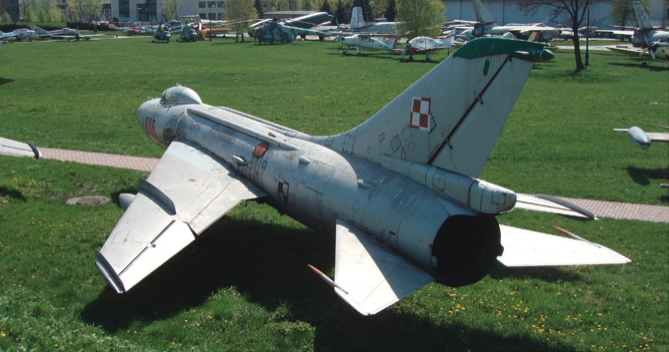
Operation of Su-7 B
The first version of the Su-7 B entered the armament of CCCP in 1960 and it was the first version of the fighter-bomber aircraft not yet adapted to carry a nuclear bomb. She performed combat tasks using conventional bombs, unguided missiles and cannons.
For simple flights, the pilot dressed the usual overalls and a pilot. He didn’t wear a helmet. For high altitude flights (and high altitudes) and / or supersonic flights, the pilot put on a K3M altitude suit and a sealed helmet. In the cockpit, the pilot hooked up to the installation of the aircraft: oxygen, radio. The pilot uses the KS-1 catapult chair (Kresło Suchoja). It saves the pilot up to 1,000 km / h, from a ceiling of 50 m. New versions of KS-2, KS-3 and KS-4 appeared in subsequent versions.
Before flying from the plane, the operator pulls the nozzle cover and air grip, as well as the tarpaulin cover from the Pitot tube and the angle of attack and side slide sensors. The aircraft is refueled and has operational fluids. The pilot receives a report from the aircraft technician and performs visual-manual rounds. He pays close attention to the control surfaces, the air grip with its central cone (from Russian called Konus), the exhaust nozzle, the installation of suspensions. After taking a seat in the cockpit, the pilot attaches to the installation of the aircraft: radio, oxygen, etc. The pilot establishes radio contact with the Flight Manager and obtains permission to start taxiing. Taxiing should take place at a speed of about 25 km / h.
A simple flight near the airport
On DS (RWY), when the pilot increases the engine speed to maximum, the Su-7 B plane tilts its bow down. After releasing the brakes, the aircraft quickly accelerates. For about 300 m it is still leaning forward, later leveling. After about 600 m, the pilot lifts the front wheel. At approximately 1,000 m, the plane breaks off from the ground. At a height of 15 m, the pilot retracts the chassis and reduces engine speed by up to 80%. The climb at an angle of 50-60 degrees occurs at a speed of 600 km / h. At a ceiling of 6,000 m, the aircraft is at the optimum height for the structure and maintains 800 km / h in horizontal flight.
The inclination of the aircraft during take-off is not favorable. In this way, the engine very easily sucks in foreign matter from the DS, and as a result, the engine failed. Suction of foreign bodies from the airport apron was partially eliminated (from 26 production series) by shortening the main landing gear by 113 mm, thanks to which the front of the aircraft and thus the air inlet rose slightly upwards. This change also facilitated losses and landing. The next step was to install two nozzles under the air grip, which with the help of air taken from the engine compressor, blow away foreign objects from the aircraft’s run. Not all aircraft received this arrangement.
The Su-7 B belongs to medium maneuverable combat machines. In this construction, speed and ceiling were valued more than maneuverability. At a speed of 450 km / h, 360 degrees grass 35 seconds. The 450 km / h loop requires 1,600-1,800 m high. The barrel lasts 5 seconds. The 900 km / h loop requires approximately 3,500 m in height. The combat turn at a speed of 900 km / h will take the aircraft up 300-350 m.
Flights at max speed.
The Su-7 B aircraft on a ceiling of 6,000 m rises at a speed of 750 km / h and 85% engine speed. At a ceiling of 6,000 m, the pilot increases the engine speed to 100% and the aircraft continues to rise at a speed of 850 km / h. When the aircraft reaches the ceiling of 12,000 m, the pilot turns on the afterburner (forage). The afterburner operation indicator lights up on the desktop. Fuel consumption increases significantly. The plane cannot be further than 80-100 km from the airport, because it may lack fuel. Therefore, flights at supersonic speed are performed towards the airport. At max speed, the Su-7 B should not fly more than 2 minutes. After turning off the afterburner, the plane quickly loses speed to Ma 0.9. Aerodynamic brakes can be used to slow down the speed.
Flights to max altitude.
The 12,000 m ceiling is achieved in the same way as for maximum speed flights. The plane should not be further from the airport than 130-150 km. At an altitude of 12,000 m, the engine speed is reduced to 92% and the aircraft accelerates to a descent of 10,500 – 11,000 m. The afterburner turns on and starts the climb. At the ceiling of 13,000 m will be speed Ma 1.8, at 17,000 m speed will be 1,9. Then the angle of attack increases even more and goes out to 19,500 m, while the speed will decrease to Ma 1.7. The afterburner turns off. This ceiling can be operated for about 5 minutes, with each turn maneuvering resulting in a loss of altitude. The ceiling will also decrease because the speed will decrease. The descent starts at Ma 0.9.
Landing.
Landing takes place from a high incident, with a sharp descent angle. At 6,000 m, the speed should be 600 km / h. After the fourth turn, the aircraft should be on a straight landing. Then the speed should be around 450 km / h. Below the speed of 450 km / h the chassis is exposed. After extending it, the pilot must correct the position of the aircraft with a rudder trimmer. 70% engine speed. Above the further beacon (about 5,000 m before the DS threshold) the Su-7 aircraft should have a ceiling of 350 m and a speed of 350-360 km / h. The pilot can assist with aerodynamic brakes. Above the nearest beacon (about 1,000 from the DS threshold) the height should be 100-120 m and speed 350-360 km / h. The leveling starts at a ceiling of 10-15 m and a speed of 320-340 km / h. The alignment is to end at a ceiling of 1 m above DS. Then the engine speed is given on low gas. After the touchdown, keep the front wheel up (large angle of attack) over a distance of 400-450 m. Lower the aircraft front at 220-240 km / h. Then the braking parachute is released. The plane has one parachute with an area of about 15 square meters. After finishing with DS, the parachute is discarded in the designated place. The same parachute system is in the Su-7 BM version. Subsequent versions have received a much better parachute system. The parachutes were placed at the base of the vertical tail, not under the engine. They can be released even just before the touchdown. They can withstand a speed of 320 km / h. There are two round parachutes with an area of 2 x 25 m square.
Control system.
The Su-7 B aircraft control system consists of ailerons, plate altitude rudder and rudder. The system has hydraulic non-returnable amplifiers. One for each control surface. The flaps on the wings are complementary.
The Su-7 B aircraft received a system to eliminate the Duch Roll phenomenon, which in the Russian nomenclature is called "Cradle". This phenomenon occurs during the flight and consists in the fact that after completing the turn, when the pilot has already set a new course, the tail of the aircraft can begin to "sweep" and the aircraft begins to sway from side to side with tilts of +/- 10 degrees. The oblique wings clearly revealed this phenomenon that in planes with straight wings practically did not occur. The Su-7 B aircraft use the AP.106 M system, which suppresses course fluctuations (not in lateral tilts to the wing). The system consists of a drift angle and flight direction sensor, a module that converts analogue to electronic signals, an executive system and aggregate that deflects the rudder in the right direction without the participation of a pilot.
Su-7 power unit.
The first Su-7 B aircraft were equipped with the AL-7-1-100U engine with 6,800 kG (66.69 kN, 14 991.43 lbf) without afterburning and 9,600 kG (94,14 kN, 21,164.38) lbf) with afterburning. The number 100 denotes the overhaul amount expressed in business hours.
The AL-7 F-1 engine was created in the team of Archip M. Lulka under the designation TRD-31, at the beginning of the 1950s. It was the development design of the AL-5 engine. The AL-7 engine was first started in September 1952. The AL-7 engine was used to propel Su-7, Su-9, Su-11, Tu-128 aircraft. The engine has a very simple construction. During tests, the engine was troubled by pumpages. The designers used the movable blades of the first stator and the air vent behind the fourth and fifth compressor stages. Motors with movable blades of the first stator were initially marked with the prefix U (AL-7 F-1-100 U). Constructors thought the problem was solved. On April 24, 1959, the S-22-1 aircraft, the future Su-7 B, soared into the air. The firing problem returned while firing non-guided missiles. This time it was caused by rocket exhaust gases. To prevent this, the AL-7 engine received an KS-1 installation that automatically reduces engine revolutions when using missiles and after a while also automatically restores the initial engine revs. The installation did not completely solve the problem of pumping, and therefore additional operational restrictions were introduced for flights with large non-guided missiles S-24.
The engine has a 9-stage compressor, ring-pitcher combustion chamber, 2-stage turbine, afterburner and exhaust nozzle. The discharge nozzle is adjustable and can take two extreme positions. In addition to the movable central cone, the fire protection consists of one stage of adjustable stator blades and compressor bleeds after the fourth and fifth stages of the compressor.
The AL-7 engine was developed in several subsequent versions. Mainly it was about increasing the life of the engine. The engine had an increased service initially to 150 (AL-7 F-1-150) and then to 200 hours of operation (AL.-7 F1-200). AL-7 F-1-250 engine (250 hours resurs, engine weight 2 103 kg, fuel consumption 0.9 kg / kgf / h).
The final version of the Archip Lulka AL-7 engine has a thrust of 7,000 kG (68.65 kN) without afterburning and 10,000 kG (98.10 kN). The engine is equipped with an oxygen system to facilitate starting on the ground at low temperatures or high in the air. Compressor 9.5: 1 compression. The temperature in front of the turbine is 860 degrees C. The ratio of thrust to weight 3.4: 1. The Archip Lulka AL-7 engine is 6.56 m to 8.00 m long depending on the afterburner used. 1.30 m diameter. Weight from 2 010 kg to 2 200 kg depending on the version. Fuel consumption from 95.0 kg / (h · kN) to 98.9 kg / (h · kN), with post-combustion 229.0 kg / (h · kN). Time between repairs 300 hours. Total service life about 900 hours. Kerosene T-1, TS-1, RT. The Su-7 has additional air grips for cooling the engine in the turbine and afterburner area.
It is worth noting here that two-flow and two-shaft constructions have long been developed in the West. CCCP continued with simple engines. It was assumed that there was no fuel deficit, which was true and only the engine’s high thrust counts. On the other hand, simple engine designs were easier to manufacture and operate, which was not insignificant. However, the effect of this reasoning was the small range of aircraft, which resulted in a large reduction in the performance of tasks. Many crews focused on the amount of fuel remaining during the flight, not on the good performance of the task.
The Su-7 B aircraft performs well. At an altitude of 1,000 m, it developed a maximum speed of Ma 1,3, and at an altitude of 11,000 m, speed Ma 2,1. The propulsion system Su-7 B received a movable cone, which after exceeding the speed of Ma 1.1 begins to move forward and at the speed of Ma 1.5 it adopts the maximum extension. There are already three oblique shock waves on the cone and in the air channel at Ma 1.4 speed, which brakes the air to the subsonic speed at which the turbojet engine works.
In Su-7 B, the engine start is automatic and consists in activating three switches located at the central desktop posture. To control the engine, the pilot on the port side has a throttle lever. To control the engine and drive system, the pilot has to control: three lights on the left desktop (compressor operation status) and two lights on the central desktop on the right (One of them is to light up all the time, because when it goes off it means that one of the systems will fail) . Above the two controls on the central desktop are two clocks. One shows the location of the inlet cone and the other shows the location of the compressor bleeds. Two engine clocks are located on the left side of the central desktop. (tachometer, thermocouple turbine temperature). The placement of these control devices is unergonomic, but was criticized only in private conversations.
In Su-7 B, fuel is placed in fuselage tanks and wings. The tanks in the hull are four and are placed in the form of a crescent embracing the air duct and engine. The tanks in the wings are single and placed between the main chassis chamber and the end part of the wing. The capacity of the internal tanks is 2 940 liters. Therefore, all tasks performed by the aircraft should not take place more than 150-200 km from the airport. As a result, in Poland planes had two additional fuel tanks with a capacity of 2 x 600 liters as standard. The aircraft may use SPRD-110 launch powder rockets with 2 x 29.40 kN thrust. (2 x 3,000 kG).
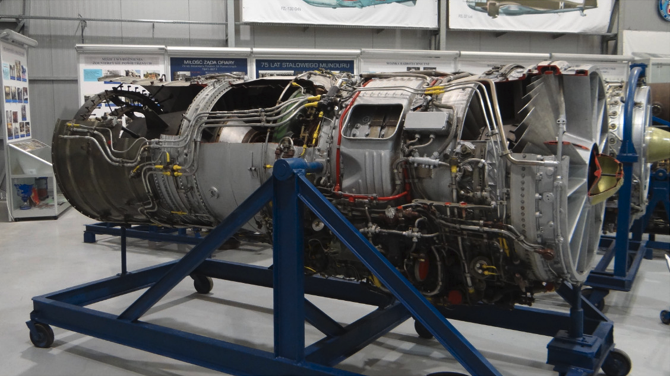
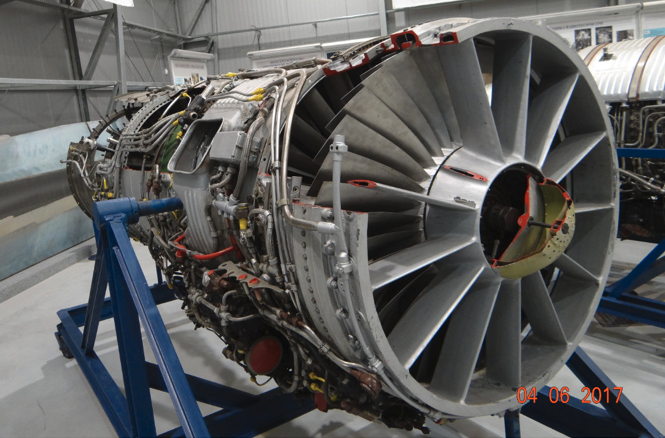
Su-7 BM


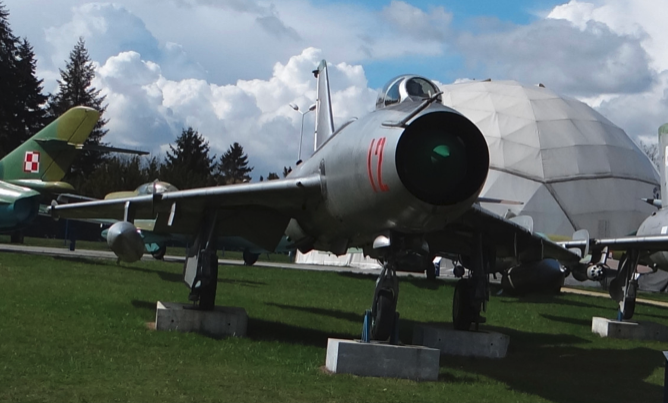
Su-7 U
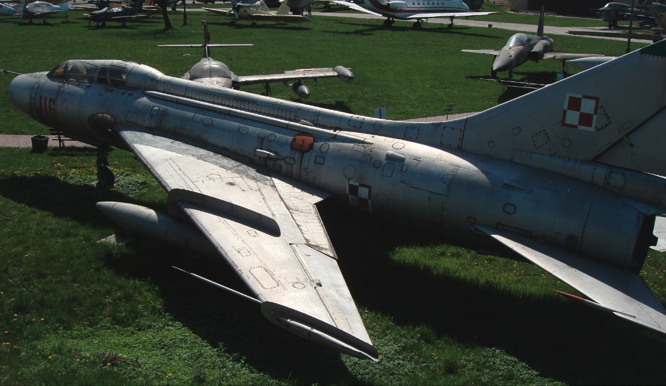
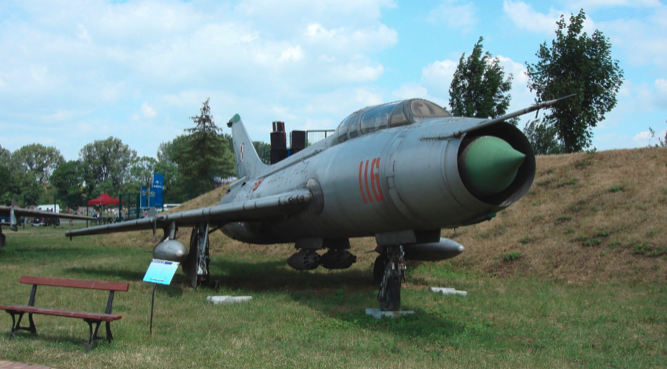
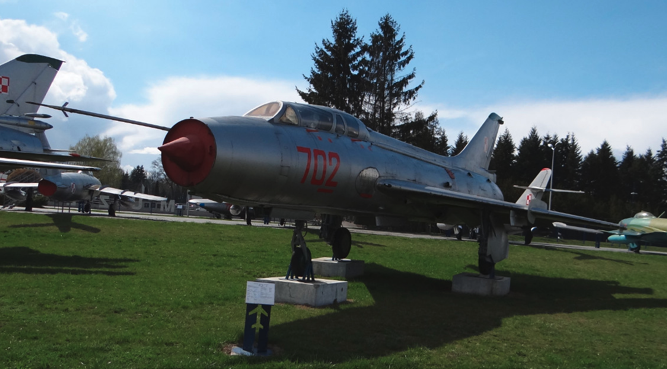
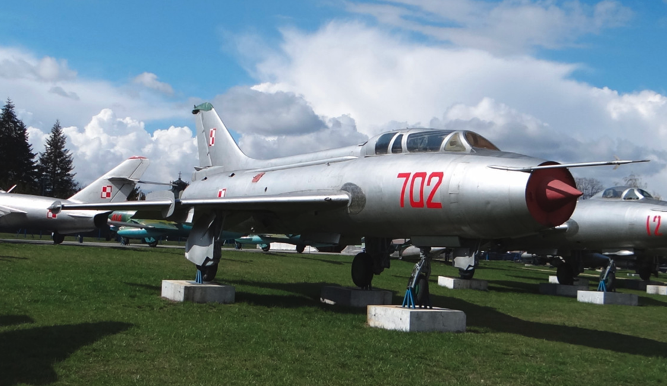
Written by Karol Placha Hetman
Kraków 2017-05-08
197 Section 1964-06-01
OKB Suchoj Su-7 B (BM, BKŁ, U)
Poland
Construction


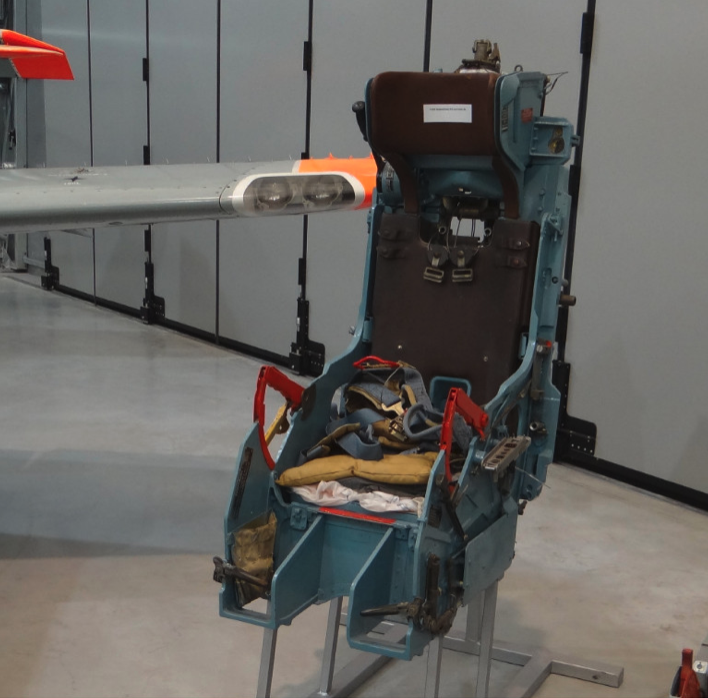
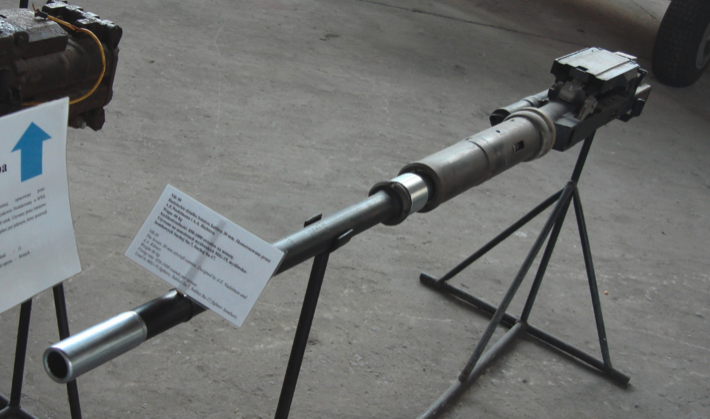

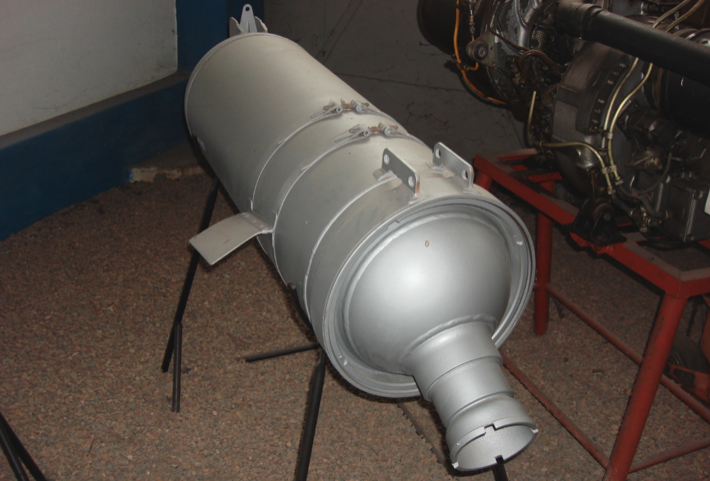
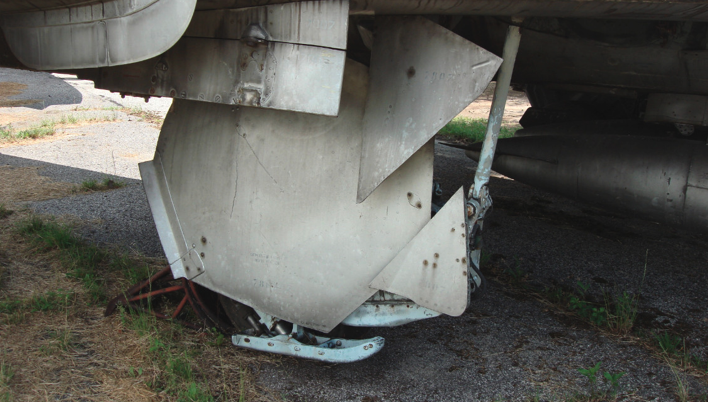
Construction Suchoj Su-7 BM
The Su-7 BM is a single-engine, single-seat, medium wing aircraft with an oblique wing. Not equipped with a radar station, but capable of performing operations in difficult weather conditions. All-metal construction, mainly made of aluminum and steel.
Double-girder wings with two auxiliary girders. The bevel angle of the leading edge is 60 degrees. Mounted at 0 wedge angle and has a negative rise of 2 degrees. The wings are equipped with two-piece, one-slot flaps with a sliding axis of rotation. "Flap wideners", ailerons and two pairs of aerodynamic steering wheels. Two 30 mm cannons were mounted at the base of the wings. Fuel tanks were placed in the wings. One armament hitch is mounted under the wings.
The circular fuselage begins with a central air grip, with a movable cone regulating the air supply to the engine. Single cabin. It protrudes from the fuselage outline. The cabin glazing consists of a permanent windscreen equipped with three windows (bullet-proof front with a flat glass) and a movable wind deflector manually moved back and equipped with a periscope to observe the rear hemisphere. Fire protection windows were used. KS-2 pilot seat, class 0/150. Behind the cab there is a compartment for equipment and fuel tanks. An engine was placed at the end of the fuselage. Four aerodynamic brakes of a rectangular shape are located at the rear of the fuselage. In the background of the fuselage a space for one braking parachute has been made. The rear of the fuselage is subtracted to replace the engine.
Plane tail horizontal plate, with a skew angle of 55 degrees and a relative thickness of 6 to 7%. Anti-flutter masses were added at the ends. The halves of the tail are interchangeable. Vertical plane of the aircraft divided into rudder and ballast.
Three-support chassis. Chassis with front wheel. Retracted and released hydraulically. The front shin is equipped with a vibration damper, which also acts as a steering (turning) wheel. All wheels single. Oil-pneumatic shock absorbers. The front landing gear retracts towards the front and is covered by two symmetrical flaps. The main landing gear retracts towards the hull. The tires have a large diameter for the possibility of using ground airports and are high pressure. The main chassis distance is 3.83 m.
Su-7 BM drive
The propulsion of the aircraft is a turbojet, single-flow, single-shaft A. Lulki AL.-7 F-1 engine with 1 x 68.65 kN thrust. (1 x 7,000 kG.) With afterburning of 1 x 98.10 kN. (1 x 10,000 kg). It consists of a 9-stage axial compressor, ring-pitcher combustion chamber, 2-stage turbine, afterburner and adjustable nozzle. The engine is equipped with an oxygen system to facilitate starting on the ground at low temperatures or high in the air. The fuel installation is located in the wings and the fuselage and amounts to 2,940 liters. You can also hang 2 fuel tanks with a capacity of 2 x 600 liters under the fuselage or wings.
Initially, the AL.-7 F-1 (TRD-31) engine with 1 x 66.64 kN thrust was used. (1 x 6 800 kG.) With post-combustion 1 x 94.08 kN (1 x 9 600 kG.).
The aircraft may use SPRD-110 launch powder rockets with 2 x 29.40 kN thrust. (2 x 3,000 kG.).
Utilities Su-7 BM
Two 30 mm NR-30 cannons.
The 4 arms hanging nodes (2 under the hull and 2 under the wings). The basic means of combat are UB-16-57U or UB-32-56U tanks with 16 or 32 57 mm S-5 shells, respectively. The machine can take up to 750 kg. bombs. The effects of the use of armament are recorded with a camera mounted in the right wing, near the fuselage.
Nuclear bombs were stored in Soviet warehouses for Polish aircraft in Poland.
Su-7 BKŁ version
Changes compared to Su-7 BM.
Aerodynamic steering wheels are reinforced on the wings. Under the wings appeared assembled since 1969, two additional hooks with a lifting capacity of 2 x 250 kg. A new KS-4 thrown chair, class 0-140, was used in the cabin. The front armored windscreen in the cabin is thinner for better visibility. Internal fuel supply increased. Aerodynamic brakes have been strengthened. The vertical arrangement has been slightly redesigned and strengthened. The main landing gear received skids. Landing is supported by two, not one braking parachute. The parachutes were placed in the container at the base of the vertical tail.
Su-7 BKŁ drive
The drive unit is the AL.-7 F-1-250 engine, whose service life has been extended to 250 hours. The engine weight is 2 103 kg. Fuel consumption 0.9 kg / kG / h. The drive unit is supported by SPRD-110 start accelerators with 2 x 29.40 kN (2 x 2 998 kG).
Construction Su-7 U
The basic difference between airplanes is the use of a two-person cabin in a tandem arrangement. The hull is 0.20 m longer. A superstructure was placed on the fuselage in which equipment moved from behind the pilot’s cabin was placed. Despite the reconstruction of fuselage fuel tanks, its quantity is almost identical to the Su-7 BM version.
Individual cabin covers are lifted up to the rear pneumatically. The rear cabin is equipped with a folding periscope. Its mirrors are made of polished metal. The periscope can be used up to a speed of 600 km / h. (The reinforced version of the periscope is used up to a speed of 850 km / h).
The crew received a special version of KS-4 U-22 ejection seats, the first pilot’s seat and then the instructor’s seat always fired, regardless of who initiated leaving the plane.
The chassis (often treated badly by young pilots, especially during landings) and its brakes were strengthened. The front shin of the chassis was equipped with brakes and could be controlled hydraulically. The chassis braking system has received a system that sprinkles alcohol with wheel hubs for more efficient cooling.
The increase in the weight of the aircraft caused restrictions in the armament carried, the maximum suspension capacity was limited to 2,500 kg, some machines did not receive a left-wing 30 mm cannon. However, the possibility of carrying nuclear bombs was left. The sight used on the school plane is a modification with Su-7 BM marked as ASP-5ND-7U replaced from 12 production series by a newer ASP-PF-7U.
Data Suchoj Su-7 B
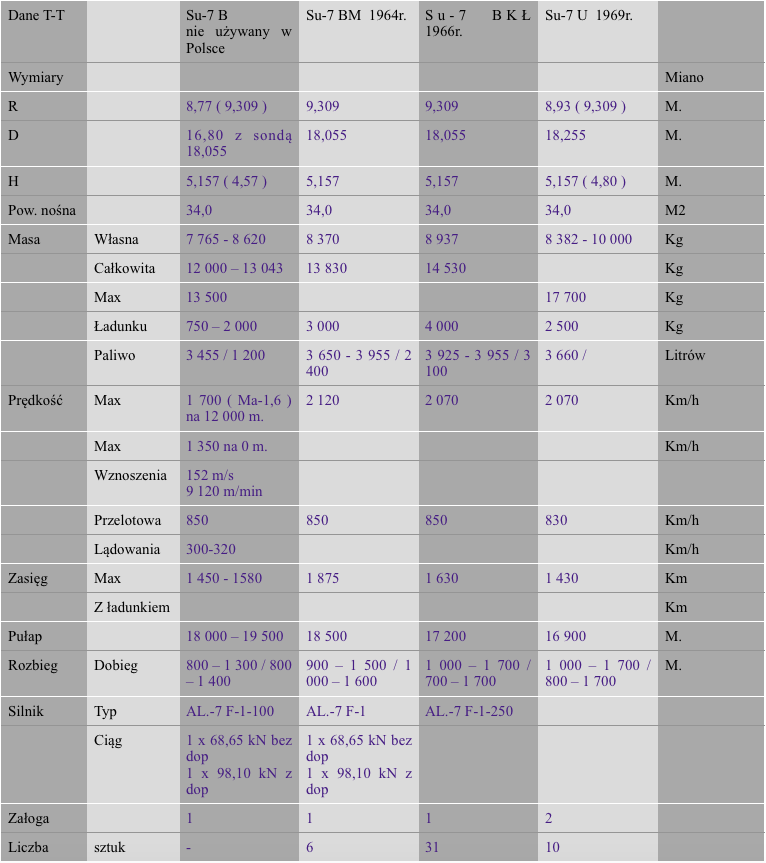
Written by Karol Placha Hetman
Kraków 2017-05-08
197 Section 1964-06-01
OKB Suchoj PL Su-7 B (BM, BKŁ, U)
Poland
Tally
The tally of Sukhoi Su-7 planes used in the Polish Army can be found in Section "Sukhoi Su-7 B. 1964.
Written by Karol Placha Hetman
